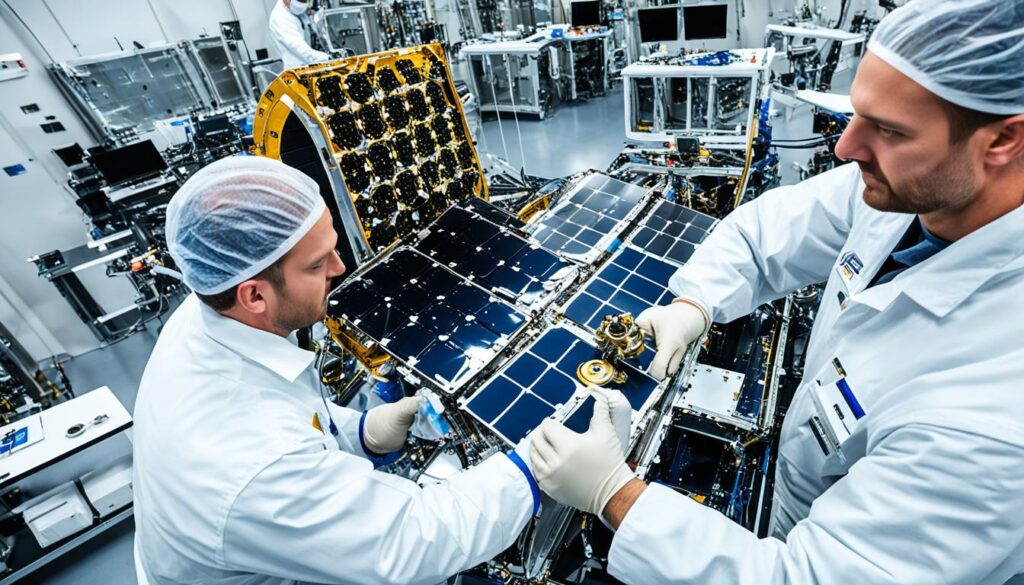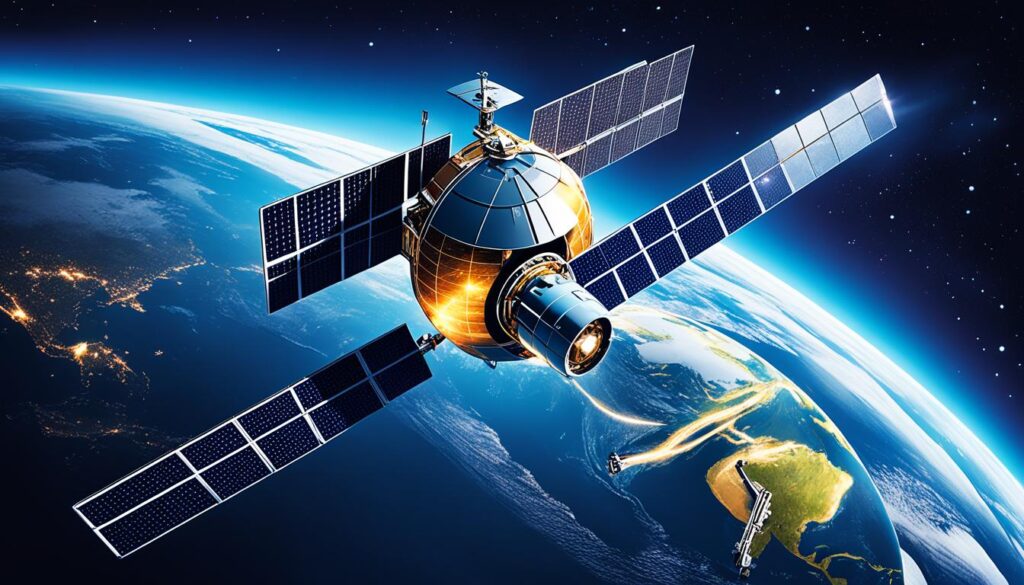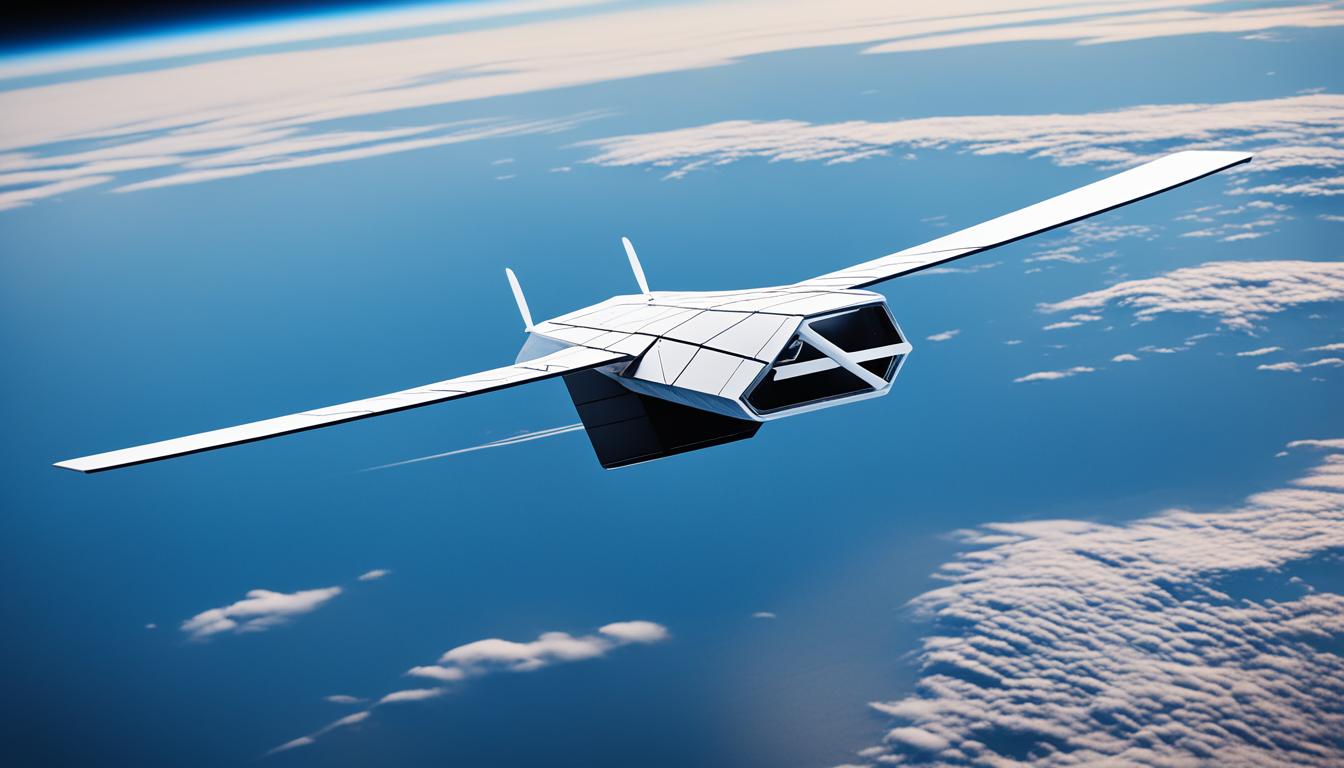“As an Amazon Associate I earn from qualifying purchases.” .
Danish startup Space Inventor is at the forefront of space exploration. They are leading in satellite development, aerospace engineering, and Earth observation. This startup focuses on nanosatellites and advanced space technology. It’s changing the game in Denmark’s space industry.
This company is passionate about exploring space and solving global problems. Space Inventor uses its aerospace knowledge to make new solutions for space. They design small satellites and create high-tech communication systems. They are leading the way in space technology innovation.
Key Takeaways
- Space Inventor is a pioneering Danish startup developing innovative space technology solutions.
- The company specializes in nanosatellites for Earth observation and climate monitoring.
- Space Inventor’s expertise in aerospace engineering enables cutting-edge space tech products and services.
- The startup is revolutionizing the Danish space industry with its innovative approach.
- Space Inventor’s solutions focus on satellite development, communication systems, and space exploration.
Pioneering Small Satellite Modules
The Danish startup Space Inventor leads in creating cutting-edge small satellites and nanosatellites. They are known for their unique modular satellite design. This makes their work top-level in the aerospace engineering field.
Space Inventor’s Modular Approach
Space Inventor made a big step with their modular system for CubeSats and small satellites. They put together parts like shielding and thermal control into modules, which makes building easier.
Benefits of Modular Satellite Design
The method by Space Inventor brings many benefits:
- It makes satellites stronger and last longer.
- It allows testing and adding parts easily before finalizing the satellite.
- It makes parts upgradable, thus extending a satellite’s life.
This method helps Space Inventor work quickly and deploy new small satellites fast for aerospace engineering uses.
Danish startup Space Inventor: Breaking New Ground
The innovative space solutions from the Danish startup Space Inventor are boosting Denmark’s space industry. They won a big grant from the European Space Agency (ESA) and Danish government. This grant is for their upcoming mission, EDISON IOD.

Space Inventor from Denmark will soon send a 6U satellite into space. They plan to test their new satellite technology and a laser satcom module. This mission is a chance for them to prove their work.
Space Inventor’s way of making CubeSats is changing the game for space engineers. It makes building satellites much easier and faster than before.
Space Inventor is doing things differently by not stacking circuit boards in their satellites. Instead, they use a modular method for building satellites. This change will make adding new tech, like the laser satcom, much simpler.
The grant shows how much the ESA and Denmark believe in Space Inventor’s work. Their projects are key to making the Copernicus satellites program better at watching over our planet.
The Future of Space Exploration
The space industry is growing fast, thanks to small satellites. They are opening new doors for exploring space and changing how we use satellites. These small, affordable satellites are used for many tasks. They help with private wireless networks, studying the world, and GPS.
Small Satellites and Their Applications
By 2029, the small satellite market will jump to USD 260.56 billion. This big growth comes from the need for more satellites. They help with things like talking on the phone, watching Earth, and research.
Small satellites are better in many ways than big ones. They cost less to make and launch, can be ready quickly, and you can make many of them. This makes them perfect for groups wanting their own fleet of satellites or to work together on space projects.
Advanced Space Manufacturing Technologies
With small satellites rising, so is cool manufacturing in space. 3D printing, robots, and using light to make stuff are here. They’re making big space things, reusable rockets, and sharper satellite sensors.
But, 3D printing is really changing things. It crafts hard-to-make parts whenever you need them. This takes away long waits for parts and makes space jobs greener and better.
| Technology | Applications | Benefits |
|---|---|---|
| 3D Printing | Satellite components, spacecraft parts, habitats | Rapid prototyping, customization, reduced waste |
| Space Robotics | Assembly, maintenance, exploration | Automation, precision, extended mission capabilities |
| Light-based Manufacturing | Large space structures, antennas, solar arrays | Scalability, high-precision, in-situ manufacturing |
These high-tech ways of building in space aren’t just cheaper. They’re helping us explore space better and make big jumps in science and tech.
Innovative Communication Systems
The space industry is undergoing a big change in how we communicate. It’s pushing for faster data rates, secure transmissions, and wider coverage. New technologies such as laser communication and quantum key distribution are changing how we share information between Earth and space.
Laser and Quantum Communication
Laser communication relay systems are changing how we send messages. They are faster and more secure than traditional radio methods. These systems use light to send large amounts of data over long distances with less interference.
Quantum key distribution (QKD) in space makes communication ultra-secure using quantum mechanics. It uses quantum encryption, which means if someone tries to listen in on the message, we would know. This gives a new level of safety for sharing sensitive information.

CubeSat Networks for Broader Coverage
CubeSat networks are making big waves in space communication. They use a group of small satellites that work together. This setup offers wider coverage, more reliable data transfer, and keeps communication going, even if a few satellites stop working.
EnduroSat is leading the way with this technology. This Bulgarian startup focuses on NanoSats for safe communication. Their tech makes CubeSat networks more effective and able to handle different missions well.
| Company | Country | Contribution |
|---|---|---|
| CommStar | United States | Enhancing Earth-to-Moon communication with high-speed optical and radio frequency relay capabilities |
| Thorium Space Technology | Poland | Developing an ultra-flat, scalable active-matrix antenna for improved throughput and system capacity |
| Arctic Space Technologies | Sweden | Decentralizing processing power for ground stations, enabling real-time processing without latency |
The need for space-based communication is growing fast. These new methods are set to change how we send and get information. They promise better, safer, and more extensive ways of communicating in space.
Managing Space Traffic and Debris
The number of satellites orbiting Earth is growing fast. This makes managing space traffic necessary to avoid orbital congestion and support safe space activities. With more small satellites and debris from accidents, satellite tracking and collision avoidance are very important.
Satellite Tracking and Collision Avoidance
Top space groups and companies use advanced sensors to watch over satellites and
debris. They can see if a crash might happen. This lets them make a move in time to prevent an accident. They use auto-systems to work out safe paths for satellites. This lowers the chance of big crashes and keeps space stuff safe.
Active Debris Removal Initiatives
Tracking and avoiding space junk are key. But we also need to clean up the mess already there. Companies like ClearSpace and OrbitGuardians are creating ways to take out old, broken satellites. They aim to reduce the danger of stuff flying in space. This way, space travel can be safer and more sustainable.
Research shows most LEO satellites are now space junk, raising big problems for future space missions.
To solve this, a global team is making rules for space use. These rules will help control space traffic and make sure we use space wisely. By working together and following these rules, we can stop orbital congestion and keep space operations going for the long haul.
Smart Propulsion for Space Missions
There’s a push for cheaper and greener space travel. This asks for new smart propulsion tech and reusable rockets. Small companies lead this tech change, improving space missions and aerospace engineering.
Reusable Rocket Technologies
Momentus in the US is making reusable rockets. Their rockets have robotic arms. This lets them do special space jobs like docking and refueling.
Efficient Propulsion Systems
Equatorial, based in Singapore, is working on rockets for short space trips. These rockets can take small items above the Karman line. They give researchers a chance to study in space.
The future looks bright for small satellites. Their market is set to grow a lot. By 2029, it could be worth over USD 260 billion. This big jump is pushing new smart propulsion and propulsion systems for space.
| Startup | Country | Propulsion System Innovation |
|---|---|---|
| Momentus | United States | Reusable rockets with robotic arms for in-orbit services |
| Equatorial | Singapore | Commercial sub-orbital rockets for small payload delivery |
Breakthroughs in smart propulsion and reusable rockets are changing space travel for the better. They’re making space missions cheaper and greener. This innovation is reshaping the aerospace engineering world and pushing the boundaries of space.
Partnerships and Collaborations
The Danish space industry is on the rise, thanks to innovative startups like Space Inventor. They leverage international collaboration and space partnerships. With ESA ARTES, they’re tapping into ESA funding. This helps them boost Denmark’s standing in space technology globally.

ESA and Danish Government Support
Space Inventor has won big with ESA funding and help from Denmark’s Ministry of Higher Education and Science. This support shows the Danish space industry’s focus on innovation. It allows Space Inventor to work on big projects, like the EDISON IOD Mission. Here, they aim to prove their platform and showcase cool tech like laser comms.
International Cooperation in Space Tech
The DISCO project is a standout in international collaboration in space tech. It’s a team effort by Space Inventor and four Danish universities. For three years, students from these schools collaborated on the DISCO-1 satellite. This was a small 10 x 10 x 10 cm cube weighing about 1 kilogram. Their work together didn’t just boost their knowledge. It also set the stage for the DISCO-2. This new satellite is a climate satellite that will study Greenland’s glaciers from space. It’s set to launch in summer 2024.
Such partnerships link academia, industry, and global groups. They’re crucial for driving innovation and enabling big space missions.
| Project | Description | Partners |
|---|---|---|
| DISCO-1 | 10 x 10 x 10 cm nanosatellite for space experiments | Space Inventor, IT University of Copenhagen, University of Southern Denmark, Aalborg University, Aarhus University |
| DISCO-2 | Climate satellite for capturing images of Greenland’s glaciers | Space Inventor, Danish Industry Foundation, Momentus, SpaceX |
The Danish Space Industry Landscape
Denmark is now known for being a hub for innovative space technology startups such as Space Inventor. These firms use Denmark’s strong suit in aerospace engineering and advanced manufacturing. They create state-of-the-art innovative solutions for making satellites, watching Earth, checking the climate, and exploring space.
The Danish space industry plays a big part in the worldwide space technology scene. It helps build partnerships between the public and private sectors and pulls in investments and deals from around the globe. For instance, Space Inventor, a Danish startup, designs innovative small satellite modules for CubeSats. This boosts how quickly we can create satellites.
The small satellite market is estimated at USD 166.40 billion in 2024 and projected to reach USD 260.56 billion by 2029, showing a CAGR of 9.38% during the forecast period.
This sector’s growth comes from improvements in small satellites, space manufacturing, communication tech, and managing space traffic. The Global Startup Heat Map shows the most startup activity in the US, then Western Europe and India. There are also strong activities in other parts of the world, acting as hotspots in the space technology industry.
| Startup | Country | Focus Area |
|---|---|---|
| EnduroSat | Bulgaria | NanoSats for secure communications |
| Momentus | United States | Reusable rockets |
| Equatorial | Singapore | Commercial sub-orbital rockets |
| Thorium | Poland | Ultra-flat interference-free antennas |
| CommStar | United States | Earth-to-Moon communications |
| ClearSpace | Switzerland | Removal of defunct satellites |
| OrbitGuardians | United States | Active debris removal services |
The table showcases a selection of global startups and their role in the space industry. It shows how these companies are creating innovative solutions. This underlines the variety of fresh ideas coming from startups in this field.
Conclusion
Space Inventor is a Danish startup that represents Denmark’s space tech innovation ambition. It focuses on advanced satellite design and communication systems, aiming to make a big impact on the future of space exploration. With its unique building approach and strong partnerships, it plans to lead the way in global space tech growth.
The company is working on a new way to make satellites. This method makes developing and using small satellites easier, for things like tracking the Earth or watching the climate. The space tech innovation improves how satellites work, making missions cheaper and better for the planet.
Space Inventor also looks into better ways to communicate in space, like using lasers or quantum tech, along with CubeSat networks. This puts the Danish startup ahead in safely sending data from space. It’s key for missions that need quick, safe, and reliable communication.
As the future of space exploration advances, Space Inventor focuses on safe space travel and cleaning up space junk. It uses the latest in tracking, avoiding crashes, and cleaning up old satellites. This way, it’s making space a safer and more open place for everyone interested in exploring it.
FAQ
What is Space Inventor?
What is Space Inventor’s modular approach to satellite design?
What is the EDISON IOD Mission?
What are the trends in the space industry?
What are the challenges in space traffic management?
What are the developments in space propulsion?
How is the Danish space industry supported?
What role does international cooperation play in the space technology sector?
How is Denmark contributing to the global space technology landscape?
“As an Amazon Associate I earn from qualifying purchases.” .



